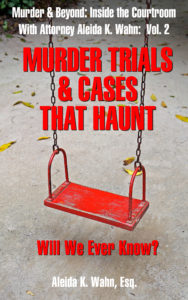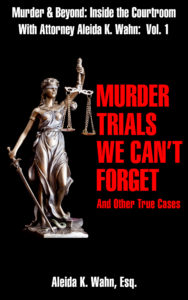
The knife rose and fell nine times in a savage attack, taking the life of the young girl who had been quietly asleep in her bed. The assailant then disappeared into the night, leaving a family unaware of the evil that had just entered their lives. In the early morning of January 21, 1998, in a rural area of Escondido, 12-year-old Stephanie Crowe was found dead on the floor of her bedroom by her grandmother who awoke to the unanswered ringing of Stephanie’s alarm clock. Although Stephanie had been stabbed nine times in her bed, she still managed to crawl towards her bedroom door, but bled to death in the doorway before she could reach help. Unbelievably, this horrifying discovery was just the beginning of the Crowe family’s nightmare. Before the family could even bury their cherished daughter, Stephanie’s brother, Michael, who was 14-years-old at the time, was charged with killing her. Within weeks, two of Michael’s teenage friends would join Michael as defendants in murder.



The Case Against Michael, Aaron & Joshua
The Escondido police summoned to the Crowe’s home could not find any forced means of entry and surmised that the murder was an inside job, although testimony later would reveal it was the Crowe family’s habit to leave their laundry room door unlocked. This door was close to the driveway and the family used it as their main entrance. The police detectives also found it disturbing that Michael appeared to be strangely unaffected by his sister’s murder, and one detective would later testify that Michael played a hand-held video game, while the rest of the family openly displayed their grief. Further suspicions arose when Michael, who had been home ill with the flu, told the police that he had gotten up around 4:30 in the morning with a headache and gone to the kitchen for Tylenol, yet did not see his sister’s body in the doorway of her room. The police believed he would have had to see his sister’s body as he passed by her room.
Michael and his younger sister Shannon, who was 10-years-old at the time, were interviewed at the police station, then separated from their parents and taken into protective custody at the Polinsky Children’s Center. Michael, while away from his parents and without their knowledge or consent, was subjected to lengthy and intense police interrogations. In the interrogation that took place a mere day after his sister’s murder, a detective from the Oceanside Police Department was brought into the case, as he operated a lie-detector machine called the Computer Voice Stress Analyzer. Following the examination on Michael, the detective told him that there were deceptions in his answers, and Michael was faced with the brutal accusation that he killed his sister. This interrogation was videotaped and showed a young Michael very distraught and sobbing as he continually proclaimed that he did not kill Stephanie. The detectives shocked Michael by telling him that they had found blood in his room, insinuated that hair found in Stephanie’s hand was his, and stated that other incriminating evidence was sure to be found. The law does allow the police to lie about evidence in the course of interrogating crime suspects in the hope that a confession will be elicited. A devastated Michael was returned to the Polinsky Center, yet his ordeal was far from over.
The next day he was again taken to the police station and subjected to further relentless police questioning. Eventually, a broken Michael conceded that if the evidence pointed to him, he must be the killer, although he could not remember anything about the killing. When one detective suggested he write a letter of forgiveness to Stephanie, he wrote a letter which became part of the confession. Pushed further, Michael revealed that he had resented his popular sister, feeling he lived in her shadow, and concluded he killed her, although he could not recall any details of the murder. Michael was immediately arrested and taken to juvenile hall. The police theorized that Michael’s jealousy of his sister and his obsession with violent video games, where he engaged in fantasy role-playing competitions and conquered villains through fierce methods, lead him to do the unthinkable. This theory was in line with a story Michael had written about a fictional character named Odinwrath who wanted to kill his sister. The detectives had also found the chilling words, “Kill, Kill” written on Stephanie’s window seal and they questioned whether Michael had written this.
Although the police had Michael’s confession, the murder weapon had still not been found. Enter Aaron Houser, who at one time had been one of Michael Crowe’s closest friends. About a week after Stephanie was found stabbed to death, Aaron’s mother called the Escondido Police Department to inform them that a knife was missing from her son’s knife collection. The police believed this knife, The Best Defense Knife, was used to kill Stephanie, and began a search for the knife. Another teenage friend of Michaels, Joshua Treadway, was found to be in possession of the knife, although his story of how he came to have the knife hidden under his bed would change many times. Initially Joshua told the police that he had admired the knife and stolen it from Aaron’s collection. Joshua was arrested on charges of petty theft and taken to the police station for questioning, which session became a shocking marathon of almost 11 hours.
Joshua was interrogated throughout the entire night and into the morning hours, causing him to be awake for over 24 hours. An exhausted, weeping, and frightened Joshua insisted he did not have anything to do with Stephanie’s murder. Throughout the questioning, Joshua kept asking when he would be allowed to get some sleep, but instead of allowing Joshua to rest, the detective kept confronting him with the awful accusation that he was in possession of the murder weapon. Joshua was confronted with the certainty that he would be the one to go down for murder if he covered for his friends. To make the point even more vivid, the detective went as far as photographing Joshua with a sign that had “187” written on it, the Penal Code section for murder. The detective bluntly told Joshua, “The evidence is going to screw you to the wall.” Then once again the detective from the Oceanside Police Department was summoned to administer the Computer Voice Stress Analyzer examination. In the early hours before dawn, Joshua took a series of exams, during which time he stuck to his story of taking the knife from Aaron. Finally as night became morning, Joshua changed his story and told the detective that Aaron had given him the knife, told him that it was used to murder Stephanie, and to get rid of it. Satisfied with this answer, Joshua was finally allowed to go home and get some sleep.
Almost two weeks later, Joshua was again subjected to a marathon interrogation that lasted approximately 10 hours. This time, Joshua stuck to the story that Aaron had given him the knife to dispose of, but kept insisting that he did not have anything to do with Stephanie’s murder. The videotaped interrogation is difficult to watch and shows a detective hell-bent on getting Joshua to confess to a conspiracy to murder Stephanie. After countless hours of repeated denials, Joshua worn down by the detective’s refusal to believe his assertions of innocence, finally told the detective what he wanted to hear. Joshua then told a story of a conspiracy between himself, Aaron, and Michael to kill Stephanie, and provided a detailed account of how the murder was accomplished. Based on this confession, Joshua Treadway and Aaron Houser were arrested. The San Diego County District Attorney’s Office obtained grand jury indictments against all three boys and the case moved quickly towards trial.
Prior to the trial, a court hearing was held to determine whether the statements police obtained from Michael and Joshua should be excluded. The judge excluded Michael’s confession as coerced. Joshua’s overnight session was also excluded because the detectives had denied Joshua sleep and food for hours. The majority of Joshua’s second interrogation was excluded because the detectives had not read him his Miranda rights until eight hours into the interrogation. The judge allowed the final two hours of Joshua’s interrogation, where Joshua detailed the planning and murder, but the judge ruled that this confession could only be used against Joshua. The judge further ruled Joshua would be tried first, followed by Michael and Aaron being tried together.
Stephanie’s Blood Found on the Clothing of Richard Tuite
Jury selection was just beginning for the Joshua Treadway trial, when the prosecution case was blown apart. Stephanie’s blood was found on the clothing worn by Richard Raymond Tuite, a transient who had a history of mental illness, drug addiction, violent outbursts, and a lengthy criminal record. Richard Tuite had been seen in the Crowe neighborhood acting erratic on the night of Stephanie’s murder, and had been knocking on doors and entering residences looking for a woman named Tracy. Richard Tuite’s behavior had so alarmed neighbors that two people called 911, and one burly neighbor even grabbed an ax for protection after seeing Richard Tuite’s face pressed against his home window. A police officer responding to the 911 call drove around the area, but did not see the transient. Close to 10:00 p.m., the officer pulled into the Crowe’s driveway, and saw the laundry room door closing. Was it someone in the Crowe family closing this door or was it Richard Tuite on his way to kill Stephanie?
On the morning Stephanie’s body was discovered, a woman called 911 as Richard Tuite was following her as she walked towards her apartment. A police officer located Richard Tuite and he was taken to the police station where the police interviewed him and confiscated his clothing, but eventually released him. It was not until the defense attorney appointed to represent Joshua Treadway requested a criminalist, who was a respected expert in DNA evidence, to test the clothing of Richard Tuite that drops of Stephanie’s blood were found on Richard Tuite’s red sweatshirt and undershirt. This finding came as a bombshell to the prosecution as Richard Tuite’s clothing had already been tested months before by the head criminalist of the Escondido Crime Laboratory and Stephanie’s blood was not found. Faced with this new finding, the murder charges were dismissed against all three boys. Richard Tuite would now stand trial. But could anyone have predicted the way it would end?
To continue reading about what happened in this heartbreaking and riveting trial, please go to Aleida K. Wahn’s book, Murder Trials & Cases That Haunt: Will We Ever Know? Aleida was there inside the courtroom for every minute, and now shares the extraordinary details of what really happened in these gripping and unforgettable trials. Order your copy today at: https://www.amazon.com/dp/B0B31PDDG3

About Aleida K. Wahn, Esq.


I am an attorney, award-winning true crime writer, and legal analyst of criminal cases. I cover criminal trials and write stories and books about compelling, gripping, and unforgettable cases that impact our world. I take you into the courtroom in high-profile murder trials, rape cases, crimes of passion, cases involving mental illness, deviant behavior, and more. I have a deep passion for true crime, criminal law, and all aspects of the criminal justice system. I have appeared as an expert on true crime shows, including “48 Hours,” “Snapped,” and “The Dead Files,” and provided legal analysis on high-profile criminal trials on Court TV, the Law & Crime Trial Network, Fox 5 News, ABC 10 News, and KUSI News. I also create and host shows with the Del Mar Television Producers Group, addressing criminal justice and social issues in recent criminal trials.
I provided my insight and legal analysis on Court TV and the Law & Crime Trial Network of the high-profile trial of former NFL star Kellen Winslow Jr. It was a trial that captured the nation as the heralded ex-football star with fame, fortune, and a famous name stood accused of multiple rapes and other sex crimes involving five women. As the trial delved into shocking facts, complicated legal issues, and unexpected twists and turns, I was there for every minute. After the trial, I wrote a book on the case, going behind the headlines to share the extraordinary details of what happened inside the courtroom. Judging Winslow Jr.: From NFL Star to Serial Rapist? Inside the Shocking Rape Trial of Kellen Boswell Winslow II is now available on Amazon.
I am passionate about telling true crime stories, as these penetrating stories have the power to move us all, while highlighting societal issues which need to be addressed. I have personally seen the human devastation which is present in each trial and believe there is a lesson to be learned in every single case. It is through awareness and examining critical issues society can effect change and even make new laws. To learn more, please visit: https://www.aleidalaw.com.
Read about the gripping and unforgettable trials that I have covered in my latest books:


